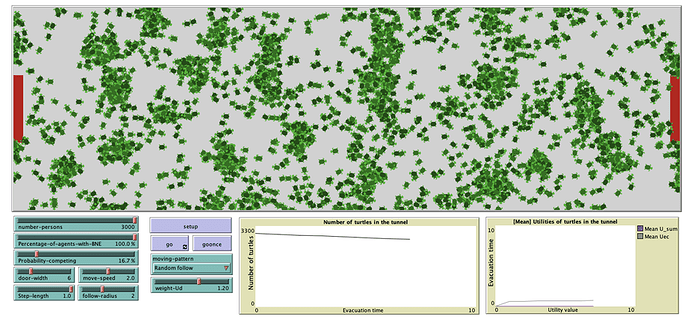An agent-based simulation model of pedestrian evacuation based on Bayesian Nash Equilibrium (version 1.0.0)
The purpose of this model is to introduce a new individual decision-making method, BNE, into the ABM of pedestrian evacuation to properly simulate individual behaviours and movements. The model was built to balance between fast evacuation and high comfortability, which is a general conflict in the domain of pedestrian research. The interactions of pedestrians with their neighbours as well as surroundings was also considered in order to simulate a more realistic pedestrian evacuation. This model ultimately aims to explore the influences of BNE on pedestrian flows from various perspectives, especially pedestrian comfort and exit time in an emergency evacuation with different parameter configurations.
Three behavioural models were evaluated: Shortest Route (SR), Random Follow (RF) and BNE. The behavioural models were used to generate four moving patterns (i.e. model configurations): SR, RF, BNE mixed with SR, and BNE mixed with RF.
An agent-based evacuation simulation model of pedestrian flow was developed by introducing BNE to realistically simulate individual decision-making process and pedestrian behaviours in an emergency evacuation. The model aims to combine Bayesian game theory and an agent-based approach at an individual level, to provide an experimental environment of pedestrian flows to support research on crowd management and evacuation planning. It was hypothesized that a BNE approach was able to positively affect individual evacuations during model simulation because of its capacity to predict future congestion levels. A series of simulation experiments were conducted with different parameter configurations to understand whether and how BNE affects pedestrian emergency evacuations.
This model consists of Three behavioural models: Shortest Route (SR), Random Follow (RF) and BNE. The behavioural models were used to generate four moving patterns (i.e. model configurations): SR, RF, BNE mixed with SR, and BNE mixed with RF, which can be selected by the chooser “moving-pattern”. The number of agents, the percentage of BNE users and other parameters can be adjusted by the corresponding sliders.
This is a companion discussion topic for the original entry at https://www.comses.net/codebases/fd29c3e3-c4b4-4360-b13a-4e05ce287b02/releases/1.0.0/
